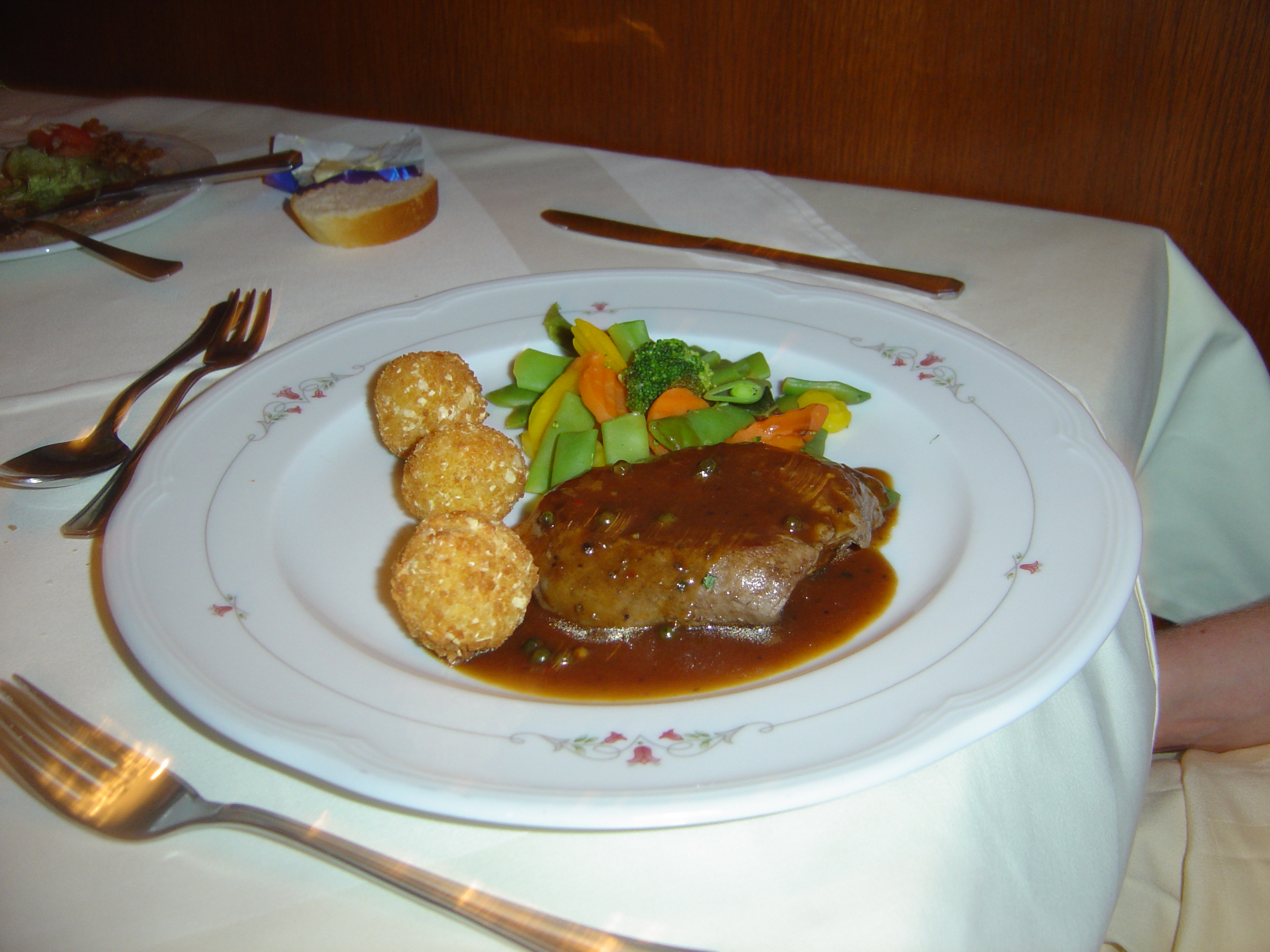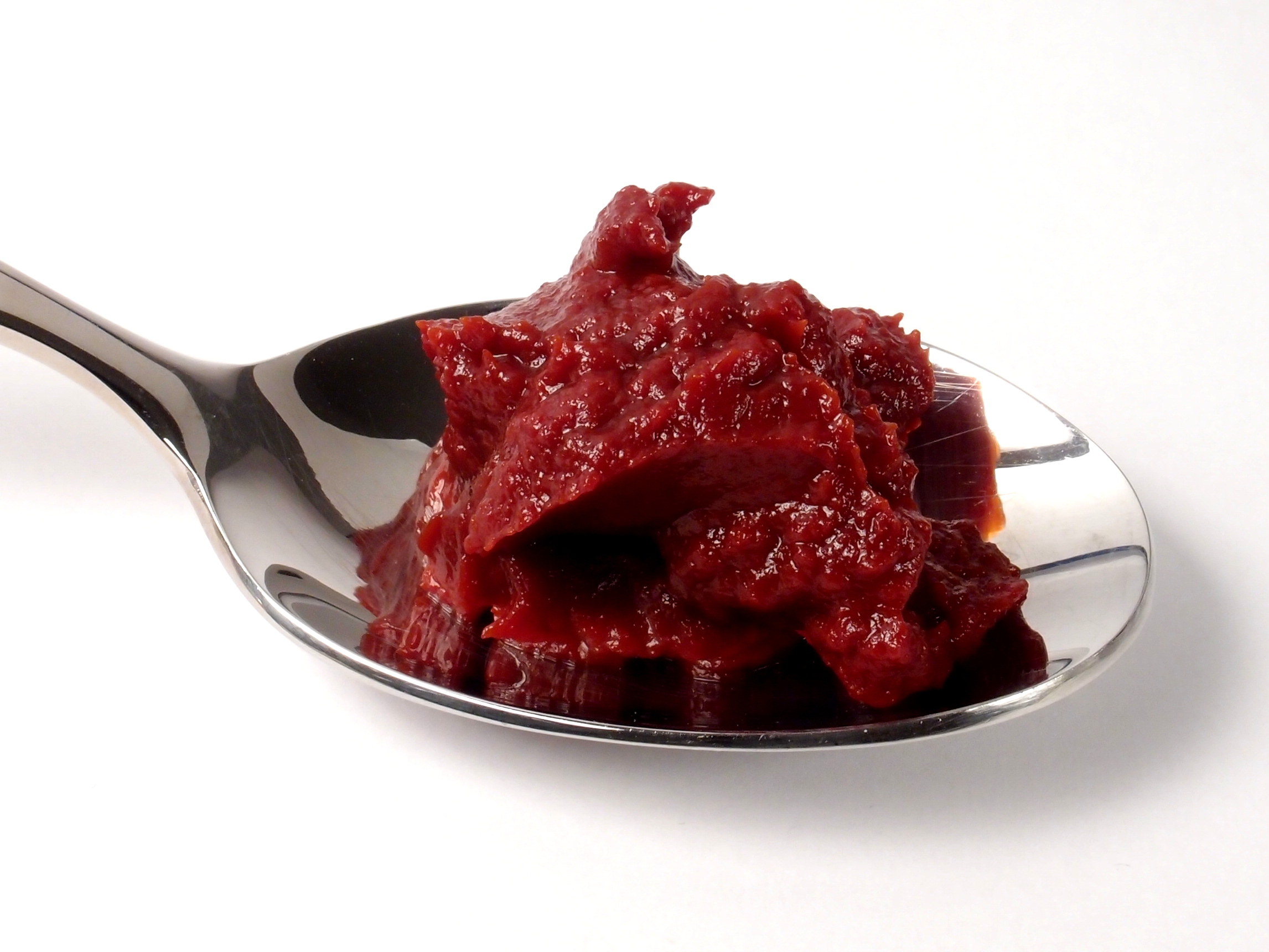|
Espagnole
Espagnole sauce () is a basic brown sauce, and is one of Auguste Escoffier's five mother sauces of classic French cooking. Escoffier popularized the recipe, and his version is still followed today.Escoffier (1903), ''Le Guide culinaire'', Editions Flammarion Espagnole has a strong taste, and is rarely used directly on food. As a mother sauce, it serves as the starting point for many derivatives, such as sauce africaine, sauce bigarade, sauce bourguignonne, sauce aux champignons, sauce charcutière, sauce chasseur, sauce chevreuil, and demi-glace. Hundreds of other derivatives are in the classical French repertoire. Escoffier included a recipe for a Lenten espagnole sauce, using fish stock and mushrooms, in ''Le Guide culinaire'', but doubted its necessity. Preparation The basic method of making espagnole is to prepare a very dark brown roux, to which brown stock (stock made from simmering roasted bones, meats and aromatics) is added, along with roasted bones, pieces of bee ... [...More Info...] [...Related Items...] OR: [Wikipedia] [Google] [Baidu] |
French Mother Sauces
In French cuisine, the mother sauces (french: sauces mères), also known as in French, are a group of sauces upon which many other sauces"daughter sauces" or are based. Different sets and classifications of mother sauces have been proposed since at least the early 19th century. The most common list of mother sauces in current use is attributed to chef Auguste Escoffier and based on those presented in the 1907 English-language edition (''A guide to modern cookery'') of his seminal cookery book ''Le guide culinaire'': * Béchamel sauce: White sauce, based on milk thickened with a white roux. * Espagnole sauce: Brown sauce based on a brown stock reduction, and thickened with a brown roux. Ingredients typically include roasted bones, bacon, and tomato (puréed or fresh). * Tomato sauce (sometimes or ): As well as tomatoes, ingredients typically include carrots, onion, garlic, butter, and flour, plus pork belly and veal broth. * Velouté sauce: Clear sauce, made by reducing clear ... [...More Info...] [...Related Items...] OR: [Wikipedia] [Google] [Baidu] |
Sauce
In cooking, a sauce is a liquid, cream, or semi-solid food, served on or used in preparing other foods. Most sauces are not normally consumed by themselves; they add flavor, moisture, and visual appeal to a dish. ''Sauce'' is a French word taken from the Latin ''salsa'', meaning ''salted''. Possibly the oldest recorded European sauce is garum, the fish sauce used by the Ancient Romans, while doubanjiang, the Chinese soy bean paste is mentioned in ''Rites of Zhou'' in the 3rd century BC. Sauces need a liquid component. Sauces are an essential element in cuisines all over the world. Sauces may be used for sweet or savory dishes. They may be prepared and served cold, like mayonnaise, prepared cold but served lukewarm like pesto, cooked and served warm like bechamel or cooked and served cold like apple sauce. They may be freshly prepared by the cook, especially in restaurants, but today many sauces are sold premade and packaged like Worcestershire sauce, HP Sauce, soy s ... [...More Info...] [...Related Items...] OR: [Wikipedia] [Google] [Baidu] |
Brown Sauce (meat Stock Based)
In classical France, French cuisine, a brown sauce is generally a sauce with a meat stock base, thickened by Reduction (cooking), reduction and sometimes the addition of a browned roux, similar in some ways to but more involved than a gravy. The classic Sauce#Sauces in French cuisine, mother sauce example is espagnole sauce as well as its derivative demi-glace, though other varieties exist. Scandinavia In Cuisine of Denmark, Danish cuisine brown sauce (''brun sovs'') is a very common sauce, and refers to a sauce with a meat stock base (in modern times, often replaced by broth made from bouillon cubes), thickened by a roux, and sometimes colored a rich, deep brown with a product consisting of dark caramelized sugar, known as ''brun kulør'' (literally, "brown colouring") or ''madkulør'' (literally, "food colouring") or collorit soya (in Sweden). It is similar to what is known in the UK as gravy browning and in the U.S. as a brown gravy. Variations include mushroom sauce, onion ... [...More Info...] [...Related Items...] OR: [Wikipedia] [Google] [Baidu] |
Vichyssoise
Vichyssoise ( , ), also known as potage Parmentier, velouté Parmentier, or crème Parmentier, is a thick soup made of boiled and puréed leeks, onions, potatoes, cream, and chicken stock. It is traditionally served cold, but it can be eaten hot. Origin Recipes for soup made of pureed leeks and potatoes were common by the 19th century in France. In 19th-century cookbooks, and still today, they are often named "Potage Parmentier" or "Potage à la Parmentier" after Antoine-Augustin Parmentier, the French nutritionist and scholar who popularized the use of potatoes in France in the 18th century. The French military cookbook of 1938 includes a recipe for "Potage Parmentier for 100 men" using milk instead of cream but with proportions and directions that are similar to the recipe for "Vichyssoise Soup" given later by Julia Child. The origins of the soup are a subject of debate among culinary historians; one version of the story is that Louis XV of France was afraid of being poisoned ... [...More Info...] [...Related Items...] OR: [Wikipedia] [Google] [Baidu] |
Brown Sugar
Brown sugar is unrefined or partially refined soft sugar. Brown Sugar may also refer to: Arts, entertainment, and media Films * ''Brown Sugar'' (1922 film), a 1922 British silent film directed by Fred Paul * ''Brown Sugar'' (1931 film), a 1931 British romantic drama starring Constance Carpenter * ''Brown Sugar'' (2002 film), a 2002 American romantic drama starring Taye Diggs Music Artists * Clydie King (1943–2019), also known as Brown Sugar, American singer, member of the vocal group The Raelettes * Brown Sugar (group), a British female vocal reggae group formed in 1976 Albums * ''Brown Sugar'' (D'Angelo album) * ''Brown Sugar'' (Freddie Roach album) a 1964 album by jazz organist Freddie Roach * ''Brown Sugar'' (soundtrack), the soundtrack to the 2002 film Songs * "Brown Sugar" (D'Angelo song) * "Brown Sugar" (Rolling Stones song), by the Rolling Stones *"Brown Sugar", a song by John Mayall from his 1967 album '' The Blues Alone'' * "Brown Sugar", song by ZZ Top fr ... [...More Info...] [...Related Items...] OR: [Wikipedia] [Google] [Baidu] |
Seasoning
Seasoning is the process of supplementing food via herbs, spices, salts, and/or sugar, intended to enhance a particular flavour. General meaning Seasonings include herbs and spices, which are themselves frequently referred to as "seasonings". However, '' Larousse Gastronomique'' states that "to season and to flavor are not the same thing", insisting that seasoning includes a large or small amount of salt being added to a preparation.'' Larousse Gastronomique'' (1961), Crown Publishers(''Translated from the French, Librairie Larousse, Paris (1938)'') Salt may be used to draw out water, or to magnify a natural flavor of a food making it richer or more delicate, depending on the dish. This type of procedure is akin to curing. For instance, sea salt (a coarser-grained salt) is rubbed into chicken, lamb, and beef to tenderize the meat and improve flavour. Other seasonings like black pepper and basil transfer some of their flavors to the food. A well-designed dish may combine seasoning ... [...More Info...] [...Related Items...] OR: [Wikipedia] [Google] [Baidu] |
Tomato Paste
Tomato paste is a thick paste made by cooking tomatoes for several hours to reduce the water content, straining out the seeds and skins, and cooking the liquid again to reduce the base to a thick, rich concentrate. It is used to impart an intense tomato flavour to a variety of dishes, such as pasta, soups and braised meat. It is used heavily in Italian cultured food. By contrast, tomato purée is a liquid with a thinner consistency than tomato paste, while tomato sauce is even thinner in consistency. History and traditions Tomato paste is traditionally made in parts of Sicily, southern Italy and Malta by spreading out a much- reduced tomato sauce on wooden boards that are set outdoors under the hot August sun to dry the paste until it is thick enough, when it is scraped up and held together in a richly colored, dark ball. Today, this artisan product is harder to find than the industrial version (which is much thinner). Commercial production uses tomatoes with thick pericarp wa ... [...More Info...] [...Related Items...] OR: [Wikipedia] [Google] [Baidu] |
White Stock
Stock, sometimes called bone broth, is a savory cooking liquid that forms the basis of many dishes particularly soups, stews, and sauces. Making stock involves simmering animal bones, meat, seafood, or vegetables in water or wine, often for an extended period. Mirepoix or other aromatics may be added for more flavor. Preparation Traditionally, stock is made by simmering various ingredients in water. A newer approach is to use a pressure cooker. The ingredients may include some or all of the following: Bones: Beef and chicken bones are most commonly used; fish is also common. The flavor of the stock comes from the bone marrow, cartilage and other connective tissue. Connective tissue contains collagen, which is converted into gelatin that thickens the liquid. Stock made from bones needs to be simmered for long periods; pressure cooking methods shorten the time necessary to extract the flavor from the bones. Meat: Cooked meat still attached to bones is also used as an ing ... [...More Info...] [...Related Items...] OR: [Wikipedia] [Google] [Baidu] |
Louis Diat
Louis Felix Diat (May 5, 1885 – August 29, 1957) was a French-American chef and culinary writer. It is also believed that he created vichyssoise soup during his time at the Ritz Paris. Biography Childhood Diat was born in 1885 in Bourbon-l'Archambault/ Montmarault, France, where his father managed a shoe store. During the summer, when Diat and his siblings desired a cold snack, Diat's mother Annette often poured milk into leftover potato-and-leek soup (''potage bonne femme''). At age five, Diat learned to cook. At age eight, he awoke early before school to cook soup. He observed the cooking of his mother and grandmother. His mother taught him tarts, while his grandmother demonstrated how to broil chicken over charcoal. By age 13, Diat resolved to become a chef, and by 14, he entered into an apprenticeship in a Moulins patisserie. Culinary profession At 18, he spent tours of duty at Paris' Hôtel Le Bristol Paris and L'Hotel Du Rhin. Diat was appointed ''chef potager'' (s ... [...More Info...] [...Related Items...] OR: [Wikipedia] [Google] [Baidu] |
French Cuisine
French cuisine () is the cooking traditions and practices from France. It has been influenced over the centuries by the many surrounding cultures of Spain, Italy, Switzerland, Germany and Belgium, in addition to the food traditions of the regions and colonies of France. In the 14th century, Guillaume Tirel, a court chef known as "Taillevent", wrote '' Le Viandier'', one of the earliest recipe collections of medieval France. In the 17th century, chefs François Pierre La Varenne and Marie-Antoine Carême spearheaded movements that shifted French cooking away from its foreign influences and developed France's own indigenous style. Cheese and wine are a major part of the cuisine. They play different roles regionally and nationally, with many variations and ''appellation d'origine contrôlée'' (AOC) (regulated appellation) laws. Culinary tourism and the '' Guide Michelin'' helped to acquaint commoners with the ''cuisine bourgeoise'' of the urban elites and the peasant ... [...More Info...] [...Related Items...] OR: [Wikipedia] [Google] [Baidu] |
Louis XIII Of France
Louis XIII (; sometimes called the Just; 27 September 1601 – 14 May 1643) was King of France from 1610 until his death in 1643 and King of Navarre (as Louis II) from 1610 to 1620, when the crown of Navarre was merged with the French crown. Shortly before his ninth birthday, Louis became king of France and Navarre after his father Henry IV was assassinated. His mother, Marie de' Medici, acted as regent during his minority. Mismanagement of the kingdom and ceaseless political intrigues by Marie and her Italian favourites led the young king to take power in 1617 by exiling his mother and executing her followers, including Concino Concini, the most influential Italian at the French court. Louis XIII, taciturn and suspicious, relied heavily on his chief ministers, first Charles d'Albert, duc de Luynes and then Cardinal Richelieu, to govern the Kingdom of France. The King and the Cardinal are remembered for establishing the ''Académie française'', and ending the revolt of ... [...More Info...] [...Related Items...] OR: [Wikipedia] [Google] [Baidu] |
Vegetable
Vegetables are parts of plants that are consumed by humans or other animals as food. The original meaning is still commonly used and is applied to plants collectively to refer to all edible plant matter, including the flowers, fruits, stems, leaves, roots, and seeds. An alternative definition of the term is applied somewhat arbitrarily, often by culinary and cultural tradition. It may exclude foods derived from some plants that are fruits, flowers, nuts, and cereal grains, but include savoury fruits such as tomatoes and courgettes, flowers such as broccoli, and seeds such as pulses. Originally, vegetables were collected from the wild by hunter-gatherers and entered cultivation in several parts of the world, probably during the period 10,000 BC to 7,000 BC, when a new agricultural way of life developed. At first, plants which grew locally would have been cultivated, but as time went on, trade brought exotic crops from elsewhere to add to domestic types. Nowad ... [...More Info...] [...Related Items...] OR: [Wikipedia] [Google] [Baidu] |







